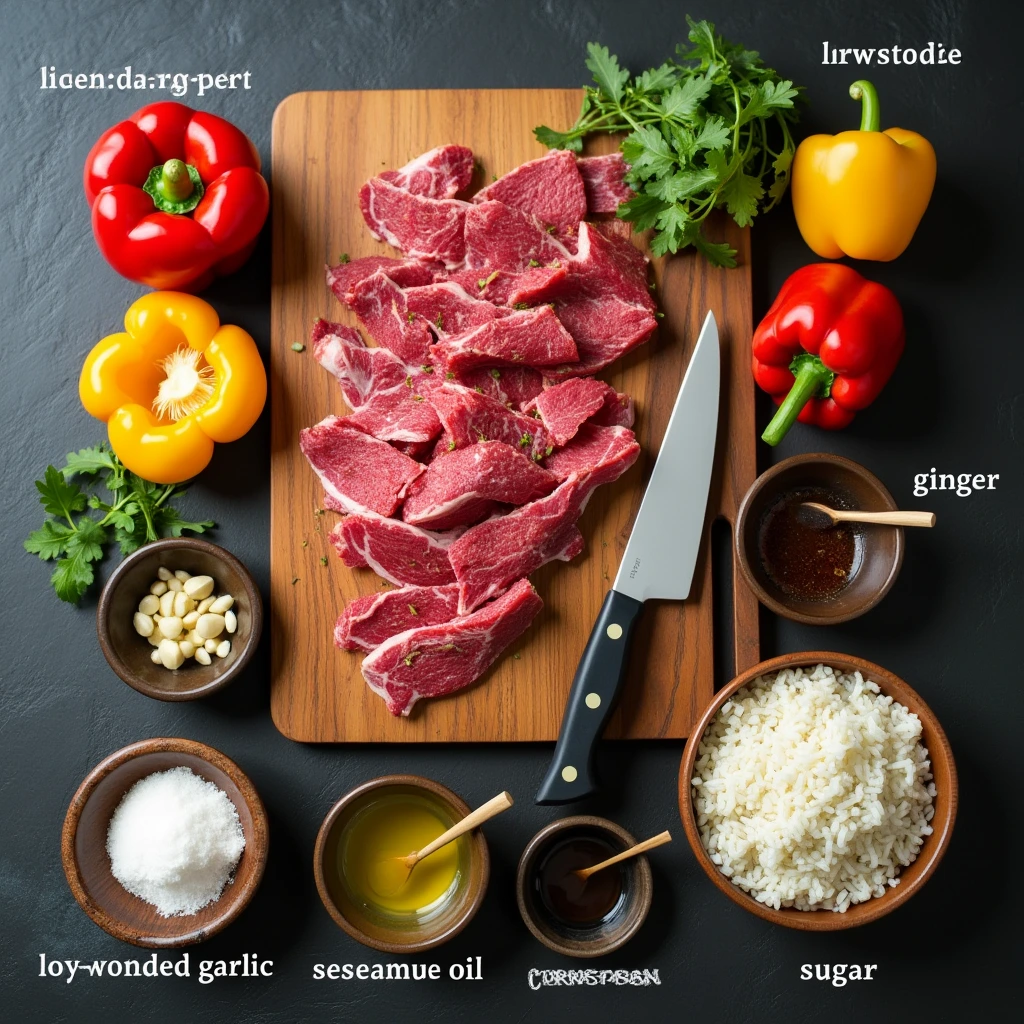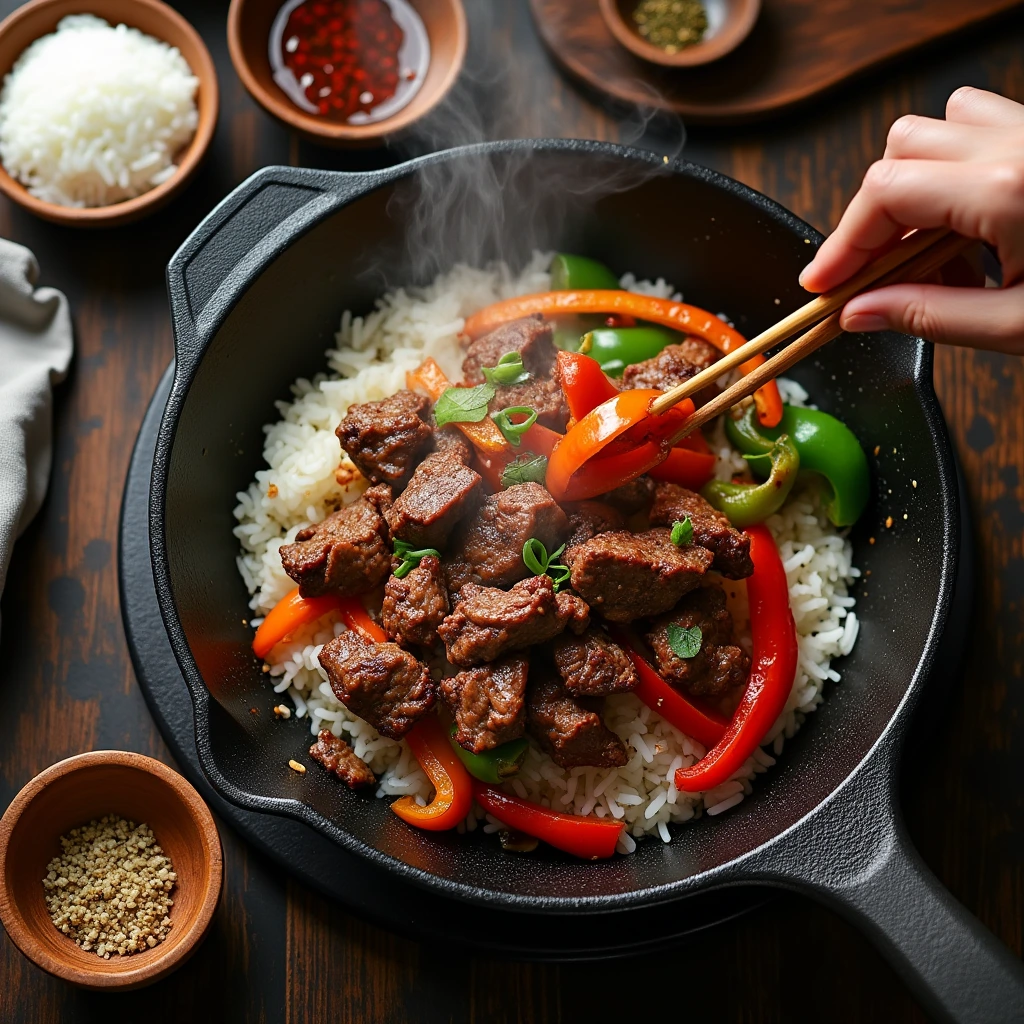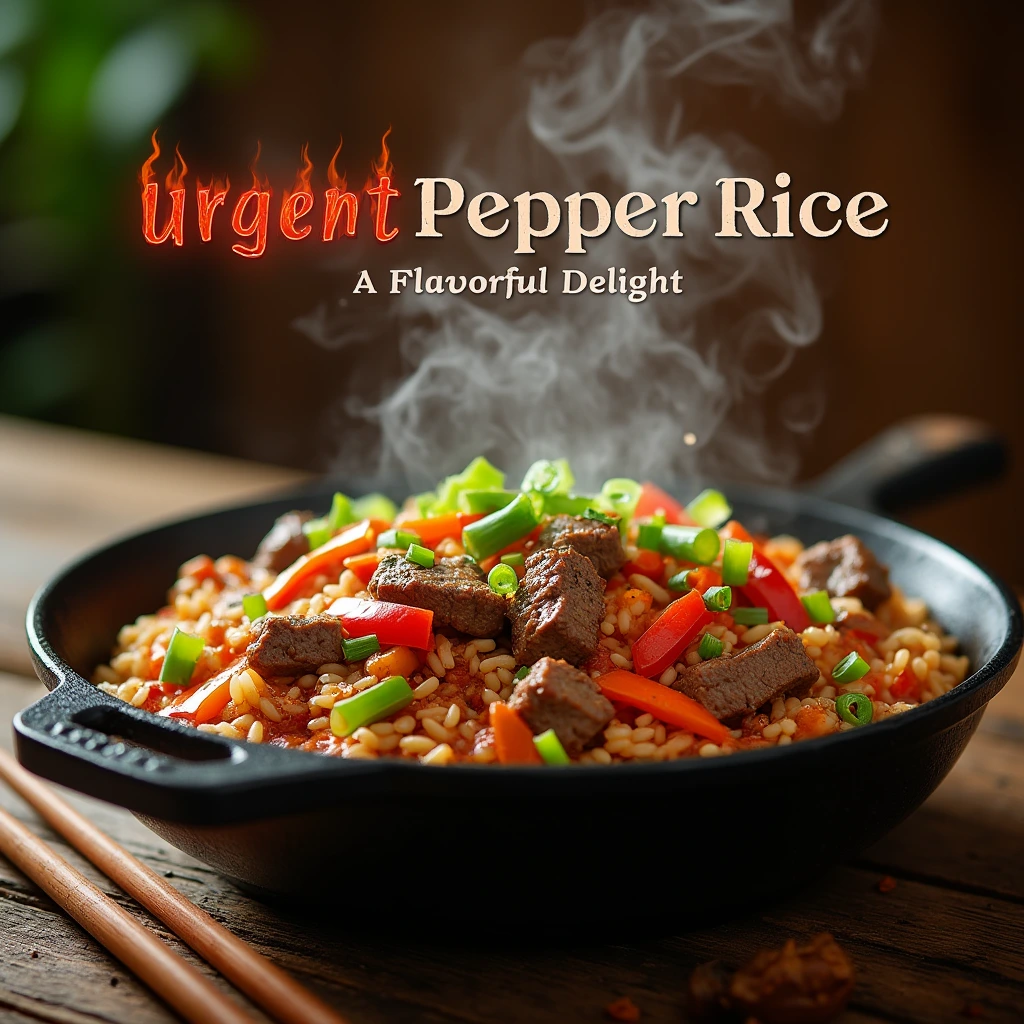Table of Contents
Beef pepper rice is a delightful dish that combines tender beef, colorful bell peppers, and fluffy rice. This recipe is not only delicious but also relatively quick and easy to prepare. Therefore, it’s an excellent option for a satisfying weeknight meal. In addition, the combination of savory beef and sweet peppers creates a harmonious flavor profile that appeals to a wide range of palates.
Why Beef Pepper Rice is a Great Meal Choice
Beef pepper rice offers several advantages as a meal. For example, it’s a complete dish providing protein, carbohydrates, and essential vitamins. Furthermore, it’s versatile and can be customized with different types of peppers and sauces.
- Nutritious: Provides a balanced combination of protein, carbs, and vitamins.
- Flavorful: Savory beef and sweet peppers create a delightful taste.
- Versatile: Easily customizable with different ingredients and sauces.
- Quick and Easy: Can be prepared in a relatively short amount of time.
- Family-Friendly: Appeals to both adults and children.
Nutritious
Beef pepper rice is a well-rounded meal that provides essential nutrients. Ultimately, it offers a balance of protein from the beef, carbohydrates from the rice, and vitamins from the peppers.
Flavorful
The combination of savory beef and sweet peppers creates a harmonious and delicious flavor profile. As a result, beef pepper rice is a satisfying and enjoyable meal.
Versatile
This dish is highly customizable, allowing you to experiment with different types of peppers, sauces, and seasonings. Consequently, you can tailor beef pepper rice to your specific taste preferences.
Quick and Easy
Beef pepper rice is relatively quick and easy to prepare, making it a great option for busy weeknights. Comparatively, many other meals require significantly more preparation time.
Family-Friendly
The mild flavors and appealing textures of beef pepper rice make it a hit with both adults and children. Furthermore, it’s a great way to introduce kids to new vegetables.
The Origins of Beef Pepper Rice
The exact origins of beef pepper rice are somewhat unclear, but it is likely inspired by Asian stir-fry dishes. Essentially, stir-fries have been a staple in Asian cuisine for centuries, featuring a combination of meat, vegetables, and rice.
Influences from Asian Cuisine
Beef pepper rice shares similarities with various Asian stir-fry dishes, which typically include meat, vegetables, and rice or noodles. Similarly, the use of soy sauce and other Asian-inspired sauces is common in these dishes.
Adaptation and Evolution
Over time, beef pepper rice has evolved and adapted to suit different regional tastes and preferences. Thus, many variations of the dish exist today, each with its unique twist.
Key Ingredients for the Best Beef Pepper Rice
The quality of ingredients is crucial for making the best beef pepper rice. Accordingly, selecting fresh, high-quality ingredients will significantly enhance the flavor and texture of the dish.
- Beef: Choose tender cuts like sirloin or flank steak.
- Peppers: Use a mix of colorful bell peppers for visual appeal and flavor.
- Rice: Opt for long-grain rice for a fluffy texture.
- Soy Sauce: Use low-sodium soy sauce to control the saltiness.
- Garlic and Ginger: Freshly minced garlic and ginger add depth of flavor.
- Oil: Use a neutral oil, like canola or vegetable.
Beef
Selecting the right cut of beef is essential for tender and flavorful beef pepper rice. For instance, sirloin or flank steak are excellent choices.
Peppers
A mix of colorful bell peppers, such as red, yellow, and green, adds visual appeal and a variety of flavors to the dish. Further, they provide essential vitamins and antioxidants.
Rice
Long-grain rice is recommended for its fluffy texture and ability to absorb the sauce. Therefore, it complements the other ingredients perfectly.
Soy Sauce
Using low-sodium soy sauce helps control the saltiness of the dish, allowing the other flavors to shine through. Additionally, it prevents the dish from becoming too salty.
Garlic and Ginger
Freshly minced garlic and ginger add depth and complexity to the flavor profile of beef pepper rice. Explicitly, they provide a warm and aromatic base for the sauce.
Step-by-Step Recipe: Making Beef Pepper Rice at Home
This step-by-step recipe will guide you through making delicious beef pepper rice at home. The recipe is designed to be easy to follow, even for beginner cooks.
Ingredients
- 1 pound sirloin or flank steak, thinly sliced
- 1 red bell pepper, sliced
- 1 yellow bell pepper, sliced
- 1 green bell pepper, sliced
- 2 cups cooked long-grain rice
- 2 cloves garlic, minced
- 1 inch ginger, minced
- 1/4 cup low-sodium soy sauce
- 2 tablespoons vegetable oil
- 1 tablespoon cornstarch
- 1 tablespoon sugar
- 1 teaspoon sesame oil
- Salt and pepper to taste

Instructions
- Prepare the Beef: In a bowl, mix the sliced beef with cornstarch, salt, and pepper.
- Cook the Rice: Cook the long-grain rice according to package instructions.
- Sauté Garlic and Ginger: Heat vegetable oil in a large skillet or wok over medium-high heat. Add minced garlic and ginger and sauté until fragrant.
- Sear the Beef: Add the beef to the skillet and sear until browned on all sides. Remove the beef from the skillet and set aside.
- Cook the Peppers: Add the sliced bell peppers to the skillet and cook until tender-crisp.
- Make the Sauce: In a small bowl, whisk together soy sauce, sugar, and sesame oil.
- Combine Ingredients: Return the beef to the skillet. Add the sauce and cook until it thickens.
- Serve: Serve the beef pepper rice over cooked rice.
Preparing the Rice: The Foundation of Beef Pepper Rice
The quality of the rice can significantly impact the overall taste and texture of beef pepper rice. Furthermore, using properly cooked rice ensures that it complements the other ingredients perfectly.
Choosing the Right Rice
Opt for long-grain rice, such as jasmine or basmati, for its fluffy texture and ability to absorb the sauce. As a result, these types of rice enhance the overall eating experience.
Cooking Methods
You can cook rice using various methods, including a rice cooker, stovetop, or microwave. Therefore, follow the package instructions for the best results.
Tips for Fluffy Rice
Rinsing the rice before cooking helps remove excess starch, resulting in a fluffier texture. Comparatively, unrinsed rice can become sticky and clumpy.
Searing the Beef: Achieving Perfect Flavor
Searing the beef properly is crucial for developing a rich, savory flavor in beef pepper rice. Moreover, a good sear adds texture and enhances the overall taste of the dish.
Importance of High Heat
Using high heat is essential for achieving a good sear on the beef. And so, this helps to quickly brown the outside of the meat, creating a flavorful crust.
Thinly Sliced Beef
Thinly slicing the beef allows it to cook quickly and evenly, ensuring that it remains tender and juicy. Furthermore, it makes it easier to incorporate into the beef pepper rice.
Avoiding Overcrowding
Avoid overcrowding the skillet when searing the beef, as this can lower the temperature and prevent proper browning. Ultimately, working in batches ensures that each piece of beef is perfectly seared.
Adding Peppers: A Colorful and Flavorful Touch
Bell peppers add a vibrant color and a slightly sweet flavor to beef pepper rice. Likewise, using a variety of colors enhances both the visual appeal and the nutritional value of the dish.
Selecting Fresh Peppers
Choose fresh, firm bell peppers that are free from blemishes or soft spots. Because fresh peppers have a better flavor and texture, the quality of peppers is an important factor in the recipe.
Slicing Techniques
Slice the bell peppers into uniform strips for even cooking and a consistent texture. Comparatively, irregularly sized pieces can cook unevenly.
Cooking to Tender-Crisp
Cook the bell peppers until they are tender-crisp, retaining some of their natural crunch. Ultimately, this adds a pleasant textural contrast to the dish.
Sauce Creation: Enhancing the Beef Pepper Rice Taste
The sauce is what ties all the ingredients together in beef pepper rice, adding depth and complexity to the flavor profile. Therefore, a well-balanced sauce is essential for a delicious dish.
Key Ingredients
Essential ingredients for the sauce typically include soy sauce, sugar, sesame oil, and cornstarch. Similarly, these ingredients create a savory, sweet, and slightly thickened sauce.
Balancing Flavors
Achieving a balance of flavors is crucial for a delicious sauce. In addition, adjust the amount of soy sauce and sugar to suit your personal preferences.
Thickening Techniques
Cornstarch is commonly used to thicken the sauce, creating a glossy and flavorful coating for the beef and peppers. Meanwhile, ensure the cornstarch is properly dissolved to avoid lumps.
Combining Ingredients: Bringing Beef Pepper Rice Together
Combining the seared beef, cooked peppers, and flavorful sauce is the final step in making beef pepper rice. Finally, this step brings all the elements together into a cohesive and delicious dish.
Stir-Frying Techniques
Gently stir-fry the ingredients together to ensure that they are evenly coated with the sauce. Additionally, avoid overcooking the beef and peppers to maintain their texture.
Adjusting Seasoning
Taste the beef pepper rice and adjust the seasoning as needed. Similarly, add salt, pepper, or more soy sauce to suit your personal preferences.
Serving Immediately
Serve the beef pepper rice immediately over cooked rice for the best flavor and texture. Because of its fresh ingredients, serving right away ensures the highest quality.
Tips and Tricks for Perfect Beef Pepper Rice
Here are some helpful tips and tricks to ensure your beef pepper rice turns out perfectly every time. Therefore, following these tips will help you achieve restaurant-quality results at home.
- Use a Hot Skillet: Ensure the skillet is hot before adding the beef to achieve a good sear.
- Don’t Overcrowd: Cook the beef in batches to avoid overcrowding the skillet.
- Adjust Sauce to Taste: Adjust the amount of soy sauce and sugar in the sauce to suit your personal preferences.
- Use Fresh Ingredients: Use fresh, high-quality ingredients for the best flavor.
- Serve Immediately: Serve the beef pepper rice immediately for the best texture and flavor.

Use a Hot Skillet
Using a hot skillet is essential for achieving a good sear on the beef. Explicitly, this helps to quickly brown the outside of the meat, creating a flavorful crust.
Don’t Overcrowd
Avoid overcrowding the skillet when searing the beef. Furthermore, this prevents the temperature from dropping and ensures that each piece of beef is properly seared.
Adjust Sauce to Taste
Adjust the amount of soy sauce and sugar in the sauce to suit your personal preferences. Therefore, taste the sauce and add more soy sauce for a saltier flavor or more sugar for a sweeter flavor.
Use Fresh Ingredients
Using fresh, high-quality ingredients is crucial for the best flavor. Undeniably, fresh beef, peppers, and other ingredients will significantly enhance the taste of the dish.
Serve Immediately
Serving the beef pepper rice immediately ensures that it is enjoyed at its peak flavor and texture. Because it’s best when hot, serving immediately is recommended.
Variations of Beef Pepper Rice: Exploring Different Flavors
Beef pepper rice is a versatile dish that can be adapted to suit different tastes and preferences. Comparatively, here are some variations to explore.
- Spicy Beef Pepper Rice: Add chili flakes or a dash of hot sauce for a spicy kick.
- Mushroom Beef Pepper Rice: Incorporate sliced mushrooms for an earthy flavor.
- Broccoli Beef Pepper Rice: Add broccoli florets for extra nutrients and texture.
- Teriyaki Beef Pepper Rice: Use teriyaki sauce instead of soy sauce for a sweeter flavor.
- Lemon Beef Pepper Rice: Add a squeeze of lemon juice for a tangy twist.
Spicy Beef Pepper Rice
Adding chili flakes or hot sauce to beef pepper rice introduces a spicy kick. Furthermore, this is perfect for those who enjoy a bit of heat in their meals.
Mushroom Beef Pepper Rice
Incorporating sliced mushrooms adds an earthy flavor and a meaty texture to the dish. And so, this variation is perfect for mushroom lovers.
Broccoli Beef Pepper Rice
Adding broccoli florets to beef pepper rice boosts the nutritional value and adds a pleasant crunch. Moreover, broccoli is a great source of vitamins and fiber.
Teriyaki Beef Pepper Rice
Using teriyaki sauce instead of soy sauce creates a sweeter and more savory flavor profile. Thus, this variation is a popular choice for those who prefer a sweeter taste.
Lemon Beef Pepper Rice
Adding a squeeze of lemon juice at the end brightens up the flavors of beef pepper rice. Explicitly, it adds a tangy twist that complements the other ingredients.
Serving Suggestions: What to Serve with Beef Pepper Rice
Beef pepper rice is a complete meal on its own, but it can also be served with a variety of side dishes to create a more elaborate meal. Therefore, here are some serving suggestions.
- Egg Rolls: Serve with crispy egg rolls for a classic Asian-inspired meal.
- Spring Rolls: Offer fresh spring rolls with peanut sauce for a light and refreshing side.
- Miso Soup: Serve with a bowl of warm miso soup for a comforting and flavorful meal.
- Asian Salad: Pair with a refreshing Asian salad with a sesame ginger dressing.
- Steamed Vegetables: Serve with steamed broccoli or bok choy for a healthy and nutritious side.
Egg Rolls
Serving beef pepper rice with crispy egg rolls creates a classic Asian-inspired meal. Also, the combination of savory beef pepper rice and crunchy egg rolls is a crowd-pleaser.
Spring Rolls
Offering fresh spring rolls with peanut sauce provides a light and refreshing contrast to the savory beef pepper rice. As a result, this combination is perfect for a lighter meal.
Miso Soup
Serving beef pepper rice with a bowl of warm miso soup adds a comforting and flavorful element to the meal. And so, miso soup is a classic accompaniment to many Asian dishes.
Asian Salad
Pairing beef pepper rice with a refreshing Asian salad provides a light and healthy side dish. Explicitly, a sesame ginger dressing complements the flavors of the beef pepper rice.
Steamed Vegetables
Serving beef pepper rice with steamed broccoli or bok choy adds extra nutrients and fiber to the meal. Undeniably, steamed vegetables are a healthy and nutritious side dish.
Health Benefits of Beef Pepper Rice
Beef pepper rice offers several health benefits due to its balanced combination of nutrients. Furthermore, it provides protein, carbohydrates, vitamins, and minerals.
- Protein Source: Beef is a good source of protein, which is essential for muscle growth and repair.
- Vitamin C: Bell peppers are rich in vitamin C, which supports immune function.
- Fiber: Rice and vegetables provide fiber, which aids in digestion.
- Iron: Beef is a source of iron, which is important for energy production.
- Antioxidants: Bell peppers contain antioxidants that protect against cell damage.

Protein Source
Beef is a valuable source of protein, which is essential for muscle growth, repair, and overall health. Furthermore, including beef in beef pepper rice helps meet your daily protein needs.
Vitamin C
Bell peppers are rich in vitamin C, a powerful antioxidant that supports immune function and helps protect against illness. In addition, vitamin C is essential for maintaining healthy skin and tissues.
Fiber
Rice and vegetables provide fiber, which is important for digestive health and helps regulate blood sugar levels. Similarly, fiber also promotes feelings of fullness, which can aid in weight management.
Iron
Beef is a source of iron, a mineral that is essential for energy production and helps transport oxygen throughout the body. Furthermore, iron deficiency can lead to fatigue and other health problems.
Antioxidants
Bell peppers contain antioxidants that help protect against cell damage caused by free radicals. Explicitly, these antioxidants can help reduce the risk of chronic diseases and promote overall health.
Storing and Reheating Beef Pepper Rice
Properly storing and reheating beef pepper rice ensures that it remains safe and delicious. Therefore, follow these guidelines for best results.
Storage Instructions
Store leftover beef pepper rice in an airtight container in the refrigerator for up to 3-4 days. Equally, proper storage helps prevent bacterial growth and keeps the dish fresh.
Reheating Methods
Reheat beef pepper rice in the microwave or on the stovetop. Thus, add a splash of water or broth to prevent it from drying out.
Tips for Reheating
When reheating in the microwave, cover the dish to prevent splattering and ensure even heating. Comparatively, when reheating on the stovetop, stir frequently to prevent sticking.
FAQs About Beef Pepper Rice
Here are some frequently asked questions about beef pepper rice.
Beef Pepper Rice menu?
The Beef Pepper Rice menu typically includes a combination of thinly sliced beef, colorful bell peppers, rice, and a savory sauce, often with variations like spicy or teriyaki flavors.
Curry beef Pepper Rice Recipe?
For a curry beef pepper rice recipe, add curry powder or paste to the sauce, along with coconut milk for creaminess. Adjust the spice level to your preference.
Eat with carmen beef pepper rice?
“Eat with Carmen Beef Pepper Rice” likely refers to enjoying the dish with a side or in a specific serving style recommended by someone named Carmen, which could include a particular sauce or side dish pairing.
Conclusion: Savor the Flavors of Beef Pepper Rice
Beef pepper rice is a flavorful, versatile, and nutritious dish that is perfect for a quick and easy meal. With its combination of tender beef, colorful peppers, and fluffy rice, it is sure to be a hit with your family and friends. Therefore, explore the many variations and serving suggestions to create your own unique beef pepper rice experience.

